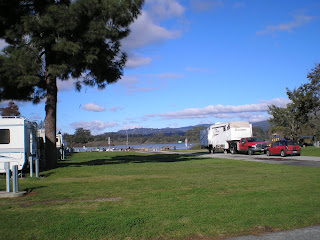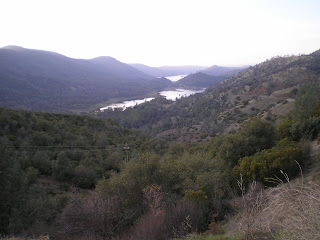Southern Rim of the North Fork of the Tuolumne River Canyon

As you can see from this first photo there's not much left of Tuolumne's Fireman's Theatre. This concrete block and brick building was constructed in 1945-1946 after the previous wooden Theatre burned down. Unlike the previous buildings, which were flat and had folding chairs which could be moved to create a dance floor, this moviehouse had a floor which sloped upward from the base of the stage at the back of the building where the screen was located to the projection booth, whose windows one could see high at the front of the building.
If memory serves, films were shown on Wednesday, Saturday, and Sunday. My late grandfather, David Wilcoxson, was one of the projectionists along with the late Adolph Antinetti [see obituary below], who was one of those who obtained the plans for this somewhat more flame-retardant building.
Despite the composition of the exterior of this Fireman's Theatre [hereinfafter TFT], the interior was still mostly wood, which led to its eventual demise via fire sometime in the early 1960s. [If you have some knowledge of the TFT because you attended movie shows there and/or are a descendant of one of the fireman who either worked on the construction of the building or who operated this film-house, please send me an e-mail.]
While I learned of a few lifelong Tuolumne natives who have some knowledge of the history of the TFT, I've just now begun to work on assembling a brief history of Tuolumne's long-running hometown cinema.
Tuolumne's Carter Cemetery [Established 1854]

Here's the headstone for my grandparents, David W. Wilcoxson and Mary Cordelia Shackelford Wilcoxson. (Obviously I'll be back this summer to remove the black plastic along with any plants and weeds which sprout next spring.)

The second Carter Cemetery photo shows the two additional gravestones in the Wilcoxson family plot. On the left is David W. Wilcoxson, Jr's and on the right is that of Cordelia's mother, Martha Elizabeth "Lizzie" Farley Schackelford Colbaugh [that's a mouthful!].

As I was leaving yesterday I noticed a barber pole within one plot. That could have been for only one person: Johnny the Barber; but I decided to return this morning to take a photo of his plot. But this morning the gate to the cemetery was closed with a "Fresh Oil" sign on it. (Had noticed some new new asphault, but didn't realize how new it was.) In any case, I had to back down the hill using my side-view mirrors -- something I try to avoid.
--
Johan "Johnny" Whittorf cut my hair many times when we five Lemmon kids spent most of the summers between 1948 and c1954 with our grandparents. Johnny had no relatives, and when he died he left a bigger estate than one might expect. Over the years he was a barber he invested in stocks. And by the time of his death in 1958 those stocks had risen in value. If memory serves, he willed the bulk of his estate to Summerville Elementary School -- though it's possible that Summerville High School also benefited from his version of The American Dream.
Obituary - Adolph Antinetti, Feb. 10, 1906 - Jan. 1, 2004
Longtime Tuolumne resident Adolph Antinetti died Thursday at a Sonora hospital. He was 97.
He was born in Angels Camp and came to Tuolumne City when he was 2 years old. His parents were Charles and Jenni Antinetti.
He served as the timber foreman of the Lightener Gold Mine in downtown Angels Camp. After traveling to Tuolumne City by the Sierra Railroad's Angels branch, they purchased and operated the Alpino boarding house, which was home to many West Side Lumber Company mill workers. Later, his parents moved to Sonora and ran the well-known Europa restaurant on Washington Street.
He attended Summerville Elementary School and Summerville High School. As a youth, he ran three trap lines south and east of town in the North Fork of the Tuolumne River Canyon. He and a close friend, "Chivy" Van Opstal, skinned their catch before going to class at the grammar school. At age 14, he worked summers in the West Side box factory and, at age 16, went to work in the woods at Hull Creek running a steam saw. At age 17, he owned and operated the Pastime Pool Hall on the corner of Chestnut and Main streets in Tuolumne. He sold candy, tobacco and sporting goods and ran card games. It was a popular establishment in those days, his family said.
On Aug. 11, 1928, he married Erna Rosasco, the daughter of Henry and Aurelia (Sivori) Rosasco, in Reno, Nev. They had two sons, Norman and Allan, who became high school teachers and coaches.
His family said he was a hard worker and pursued many interests. He worked with Fred Leighton building check dams in the Emigrant Basin. He ran a herd of cattle with Henry Rosasco. He worked for the Tuolumne County Road Department. He was a blacksmith and shoveled mine rock in the Soulsby Belle Gold Mine. During the Great Depression in 1933, he left home for seven months to take a seven-day-a-week road construction job in Sequoia National Park.
He was a Tuolumne City volunteer firefighter and was serving on the Tuolumne Fire Department Board of Directors when the first fire engine was purchased. He and a good friend, Bill Archer, acquired the plans for the Tuolumne Fireman's Theater, where he often operated the projectors.
In later years, he ran the gas shovel for West Side Lumber Company, building railroad grades at camps 43 and 44, around Woods Mountain and across Cherry Valley to Wilson Meadow. Many of these railroad grades are the present-day Forest Service roads in the area of Cherry Lake. In the 1940s, he left the woods and became part owner of the Shell gas station on Carter Street in Tuolumne. His partner was Bruce Nelson, and they ran a successful business for 24 years, his family said.
He retired in 1969 and remained active. He was a founding member of the Tuolumne Rod and Gun Club, a 41-year member of the Sonora Elks Lodge, a parishioner of St. Joseph's Catholic Church and belonged to Figli d' Italia. He loved riding his trail bike around Tuolumne and in the mountains, where he continued to fish and hunt, his family said. He rode trail bikes until he was 87 and drove his cars until he was 96.
In the early 1990s, he was co-grand marshal of the Tuolumne Jubilee Parade with his good friend, Al Bonales, with whom he cut firewood until they were well into their 90s.
He is survived by two sons and daughters-in-law, Allan and Mary Antinetti of Tuolumne and Norman and Pam Antinetti of Oakdale; grandchildren and spouses, Mark and Joanie Antinetti and Linda Antinetti Cazares, and her husband, Roberto, all of Tuolumne, Amy Antinetti of Turlock and David and Rachelle Antinetti of Oakdale; and five great-grandchildren.
A rosary is scheduled for 6 tonight at Heuton Memorial Chapel. A funeral service is scheduled for 10 a.m. tomorrow at St. Joseph's Catholic Church in Tuolumne.
Heuton Memorial Chapel is handling arrangements.
[From the 5 Jan 2004 Sonora Union Democrat]
--
F 10 Dec Route: Sonora - Groveland





































